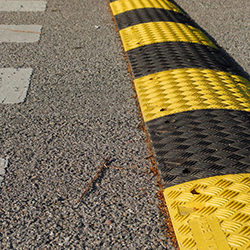What are speed bumps?
Speed bumps are traffic calming devices that are designed to reduce vehicle speeds and improve safety on roads. They are typically raised sections of pavement that force drivers to slow down as they drive over them. Speed bumps are commonly used in areas where there is a need to control vehicle speed, such as residential neighborhoods, school zones, and parking lots. They are an effective tool for slowing down traffic and preventing accidents. Speed bumps can be made of various materials, including concrete, asphalt, or rubber, and they come in different shapes and sizes. They are installed strategically to ensure that vehicles slow down to a safe speed while navigating through the area.
Importance of speed bumps
Speed bumps play a crucial role in ensuring the safety of pedestrians and vehicles in various areas such as parking lots, residential neighborhoods, and school zones. They are designed to slow down vehicles and reduce the risk of accidents and injuries. By enforcing lower speeds, speed bumps help to create a safer environment for everyone. Additionally, speed bumps can also help to control traffic flow and discourage reckless driving. Choosing the right type of speed bumps is essential to maximize their effectiveness and improve the load capacity of the area.
Factors to consider when choosing speed bumps
When choosing speed bumps, there are several factors that need to be considered to ensure optimal performance. Firstly, the traffic volume and speed of vehicles passing over the bumps should be taken into account. This will help determine the appropriate height and width of the speed bumps. Secondly, the durability and maintenance requirements of the speed bumps are important factors to consider. Traditional speed bumps are typically made of concrete and may require more maintenance compared to rubber speed bumps. Lastly, the installation requirements should be considered to ensure proper installation and longevity of the speed bumps. By carefully considering these factors, you can choose the right speed bumps that will effectively control speed while improving load capacity.
Design Considerations
Height and width
When considering the height and width of speed bumps, it is important to take into account the desired traffic speed and the type of vehicles that will be passing over them. Higher speed bumps are more effective at reducing speed but may cause discomfort to drivers and passengers. Wider speed bumps provide a larger surface area for vehicles to pass over, distributing the load more evenly. However, wider speed bumps may require more space and can be more expensive to install. Finding the right balance between height and width is crucial to ensure improved load capacity while maintaining driver comfort and cost-effectiveness.
Material
When choosing the material for speed bumps, it is important to consider durability and effectiveness. Common materials used for speed bumps include concrete, asphalt, and rubber. Concrete speed bumps are known for their strength and long-lasting performance, making them suitable for heavy traffic areas. Asphalt speed bumps are cost-effective and provide a smoother ride. Rubber speed bumps are highly flexible and can withstand extreme weather conditions. It is crucial to select a material that can withstand the load capacity and traffic volume of the area where the speed bumps will be installed.
Installation requirements
When it comes to installing speed bumps, there are a few important requirements to consider. Firstly, proper placement is crucial to ensure maximum effectiveness. Speed bumps should be installed in areas where vehicles need to slow down, such as parking lots or residential streets. Secondly, proper signage is essential to alert drivers of the presence of speed bumps. Clear and visible signs should be placed before the speed bumps to provide advance warning. Lastly, proper maintenance is necessary to ensure the longevity and functionality of the speed bumps. Regular inspections and repairs should be conducted to keep the speed bumps in optimal condition.
Conclusion
When selecting speed bumps, it is crucial to consider various factors to ensure they meet your specific requirements. Load capacity is an essential consideration as it determines the weight the speed bumps can withstand without damage. Additionally, factors such as traffic volume, vehicle types, and speed limits should be taken into account to choose the appropriate speed bumps that can effectively slow down vehicles while maintaining a smooth flow of traffic. By carefully considering these factors, you can enhance safety and optimize the load capacity of your premises.
Using appropriate speed bumps can provide several benefits for both drivers and pedestrians. Firstly, it helps in reducing vehicle speed and ensuring safer roads. This is especially important in areas with heavy pedestrian traffic, such as schools or residential neighborhoods. Secondly, properly designed speed bumps can help in improving load capacity by minimizing the impact on vehicles and their cargo. This is crucial for businesses that rely on transportation for their operations. Lastly, using the right speed bumps can also contribute to reducing noise pollution caused by vehicles. Overall, choosing the right speed bumps can enhance road safety, protect pedestrians, and optimize load capacity.
To ensure improved load capacity with the right speed bumps, several factors need to be considered. Firstly, choosing the appropriate height and width of the speed bumps is crucial. This will depend on the type and weight of the vehicles that will be using the road. Secondly, the material of the speed bumps should be durable and able to withstand heavy loads. Common materials include concrete and rubber. Lastly, proper installation requirements should be followed to ensure the speed bumps are securely and correctly installed. By considering these factors, businesses can effectively enhance load capacity and ensure the safety of their vehicles and drivers.


